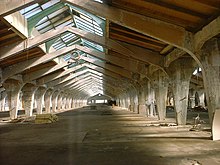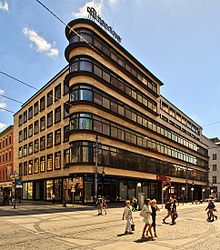Erich Mendelsohn
Erich Mendelsohn | |
|---|---|
| Died | 15 September 1953 (aged 66) |
| Nationality | German |
| Citizenship | German, British (since 1938) |
| Occupation | Architect |
| Spouse | Luise Maas (m. 1915) |
| Buildings | Einstein Tower, Potsdam De La Warr Pavilion, Bexhill on Sea Petersdorff Department Store, Breslau (Wrocław) Weizmann House, Rehovot |
| Projects | Hebrew University of Jerusalem |
Erich Mendelsohn (German pronunciation: [ˈeːʁɪç ˈmɛndl̩ˌzoːn] ⓘ); 21 March 1887 – 15 September 1953)[1] was a German-British architect, known for his expressionist architecture in the 1920s, as well as for developing a dynamic functionalism in his projects for department stores and cinemas. Mendelsohn was a pioneer of the Art Deco and Streamline Moderne architecture, notably with his 1921 Mossehaus design.
Biography
Mendelsohn was born to a
He was the fifth of six children; his mother was Emma Esther (née Jaruslawsky), a hatmaker and his father David was a shopkeeper.[3][4] He attended a humanist Gymnasium in Allenstein and continued with commercial training in Berlin.

In 1906, he took up the study of national economics at the
From 1912 to 1914, he worked as an independent architect in Munich. In 1915, he married the

Through his relationship with Freundlich, Mendelsohn had the opportunity to design and build the Einsteinturm ("Einstein Tower"). This relationship and also the family friendship with the Luckenwalde hat manufacturers Salomon and Gustav Herrmann helped Mendelsohn to an early success. From then until 1918, what is known of Mendelsohn is, above all, a multiplicity of sketches of factories and other large buildings, often in small format or in letters from the front to his wife, Louise Mendelsohn (née Maas; 1895–1980). The 2011 documentary film by Duki Dror titled "Incessant Visions" is about Erich Mendelsohn and his wife, in which Dror animates the memoirs of Louise and the letters.[6]
Architecture career
At the end of 1918, on his return from World War I,[further explanation needed] he settled his practice in Berlin. The Einsteinturm and the hat factory in Luckenwalde established his reputation. The Hat Factory was commissioned in 1921, Mendelsohn's design included four production halls, a boiler, a turbine house, two gatehouses and a dyeing hall. The dyeing hall became a distinctive feature of the factory, the building was shaped with a modern ventilation hood that expelled the toxic fumes used in the dyeing process. The structure even ironically resembled a hat.[7]
As early as 1924, Wasmuths Monatshefte für Baukunst (a series of monthly magazines on architecture) produced a booklet about his work. In that same year, along with Ludwig Mies van der Rohe and Walter Gropius, he was one of the founders of the progressive architectural group known as Der Ring. His practice employed as many as forty people, among them, as a trainee, Julius Posener, later an architectural historian. Mendelsohn's work encapsulated the consumerism of the Weimar Republic, most particularly in his shops: most famously the Schocken Department Stores. Nonetheless, he was also interested in the socialist experiments being made in the USSR, where he designed the Red Banner Textile Factory in 1926 (together with the senior architect of this project, Hyppolit Pretreaus). His Mossehaus newspaper offices and Universum cinema were also highly influential on art deco and Streamline Moderne.

In 1926, he bought an old villa, and in 1928, he designed Rupenhorn, nearly 4000 m2, which the family occupied two years later. With an expensive publication about his new home, illustrated by Amédée Ozenfant among others, Mendelsohn became the subject of envy.

In the spring of 1933, in the wake of growing antisemitism and the rise of the Nazis in Germany, he fled to England. His assets were seized by the Nazis, his name struck from the list of the German Architects' Union, and he was excluded from the Prussian Academy of Arts. In England he formed an architectural practice with Serge Chermayeff, which continued until the end of 1936 and together they designed two important private houses – Cohen House and Shrubs Wood – and the De La Warr Pavilion, an entertainment and arts complex in the seaside town of Bexhill-on-Sea, commissioned and paid for by the local landowner.
Mendelsohn had long known
From 1941 until his death, Mendelsohn lived in the United States and taught at the
Buildings (selected)




- Mendelsohn house.
- Work hall of the Herrmann hat factory, Luckenwalde (1919-1920)
- expressionist form is suggestive of concreteas a building material, but it is mostly brickwork, rendered. Mendelsohn explained this was because of delivery problems; however, there may have been difficulties in constructing the formwork for poured concrete.
- Steinberg hat factory, Herrmann & Co, Luckenwalde (1921-1923) with a strict, angular form
- Mossehaus, conversion of the offices and press of Rudolf Mosse, Berlin (1921-1923)
- Schocken department store, Nuremberg (1925-1926)
- Leningrad, 1926. Mendelsohn authored the building of the power station of the factory; the other buildings were authored by S. O. Ovsyannikov, E. A. Tretyakov, and Hyppolit Pretreaus, who was the senior architect of this project. The complex of buildings of this factory is included in the List of the objects of historical and cultural heritage issued by the government of Saint Petersburgin 2001 (with additions of 2006).
- Extension and conversion of Cohen & Epstein department store, Duisburg (1925-1927)
- Schocken department store, Stuttgart (1926-1928). The department store, together with the Tagblatt-Turm (1924-1928) of Ernst-Otto Oßwald across the way, constituted an impressive ensemble of modern architecture, and was damaged only lightly in World War II. In 1960, the city of Stuttgart demolished the store, despite international protest. In its place today stands Egon Eiermann's unremarkable department store building (Galeria Kaufhof, previously Horten).
- Exhibition pavilion for the Rudolf Mosse publishing house at the Pressa in Cologne (1928)
- Woga-Komplex and Universum-Kino (cinema), Berlin (1925-1931)
- Schocken department store, Chemnitz (1927-1930), known for its arched front with horizontal strips of windows.
- His own home, Am Rupenhorn, Berlin (1928-1930)
- Berlin-Tempelhof, demolished 1937).
- Bachner department store in Ostrava (1932-1933)
- Jewish youth center, Essen (1930-1933)
- Nimmo House (later renamed Shrubs Wood by former owner Bridget D'Oyly Carte), Chalfont St Giles, Buckinghamshire, England (1933–1934). In collaboration with Serge Chermayeff.
- The De La Warr Pavilion, The Promenade, Bexhill-on-Sea, Sussex, England (1934). Commissioned by Earl De La Warr and designed in partnership with Serge Chermayeff.
- Norman Foster
- (1935-1936)
- Built around the same time: a cluster of three buildings on the MRI, and the Kimmel Center for Archeology, respectively
- Hebrew University, Jerusalem (1934-1940)
- Synagogue B'Nai Amoona, now Center of Creative Arts, University City, Missouri (1946-1950)
- Maimonides Hospital, San Francisco (1946-1950)
- Park Synagogue, Cleveland Heights, Ohio (1947-1951)
- Beth El Synagogue, Baltimore, Maryland (1948)[11]
- Russell House, San Francisco, California (1951)
- Mt. Zion Temple, St. Paul, Minnesota (1950 – 1956). Construction completed after his death.
Published works (German)
- Erich Mendelsohn: Amerika. Bilderbuch eines Architekten (1976) Berlin: Nachdruck Da Capo Press, ISBN 0-306-70830-2
- Erich Mendelsohn: Rußland – Europa – Amerika. Ein architektonischer Querschnitt. (1929) Berlin
- Erich Mendelsohn: Neues Haus – Neue Welt. Mit Beiträgen von Amédée Ozenfant und Edwin Redslob (1932) Berlin. Reprinted, with an afterword by Bruno Zevi (1997) Berlin
References
- ^ "Erich Mendelsohn". Encyclopædia Britannica. Retrieved 15 January 2012.
- ^ "This Day in Jewish History / Architect Erich Mendelsohn is born". Haaretz.
- ^ a b "History - Jewish community before 1989 - Olsztyn - Virtual Shtetl". sztetl.org.pl. Archived from the original on 1 January 2014.
- ^ Erich Mendelsohn in Berlin
- ^ Menelsohn. "Correspondence of Erich and Luise Mendelsohn 1910–1953". getty.edu.
- ^ Esther Zandberg, "Something Eternal" Haaretz, July 7, 2011.
- ^ Architectuul
- ^ Incessant Visions, Something Eternal
- ^ Artists in Exile
- ^ Quoted by Mike Davis in Chapter 3 of his work Dead Cities. The original reference, according to this online version of the chapter Archived 28 May 2020 at the Wayback Machine, is "Design and Construction of Typical German and Japanese Test Structures at Dugway Proving Grounds, Utah" 27 May 1943, by the Standard Oil Development Company.
- ^ "Modernistic New Synagogue To House Beth El Activities". The Baltimore Sun. 11 May 1948. p. 13.
Bibliography
- Bruno Zevi (1999) E. Mendelsohn – The Complete Works. Birkhäuser Verlag ISBN 3-7643-5975-7
- Von Eckardt, Wolf (1960) Masters of World Architecture: Eric Mendelsohn London: Mayflower. ISBN 0-8076-0230-2
- Whittick, Arnold (1956) Erich Mendelsohn (2nd Ed.). New York: F.W. Dodge Corporation
- Erich Mendelsohn: Complete Works of the Architect: Sketches, Designs, Buildings (1992 translation of Berlin, 1930 1st ed.) Princeton Architectural Press
- David Palterer, Erich Mendelsohn: Nuove riflessioni (New reflections). Ed. Tre Lune Edizioni, 2004. ISBN 8887355843, 100 p. ill.
- David Palterer, "Tracce di Mendelsohn", in Domus, 646, 1984, pp. 4–9
- Erich and Luise Mendelsohn papers, 1894-1992. Research Library at the Getty Research Institute. Los Angeles, California.
- —, Erich Mendelsohn: Das Gesamtschaffen des Architekten. Skizzen, Entwürfe, Bauten (1930) Berlin, Reprinted by Vieweg-Verlag, Braunschweig/Wiesbaden, 1988, ISBN 3-528-18731-X
- —, Erich Mendelsohn – Dynamik und Funktion, Katalog zur Ausstellung des Instituts für Auslandsbeziehungen e. V. (1999) Hatje Canz Verlag
- Julius Posener: "Erich Mendelsohn". In: Vorlesungen zur Geschichte der neuen Architektur, special issue of Arch+ for the 75th birthday of Julius Posener. Nr. 48, December 1997, 8-13
- Ita Heinze-Mühleib: Erich Mendelsohn. Bauten und Projekte in Palästina (1934-1941)
- Sigrid Achenbach: Erich Mendelsohn 1887-1953 : Ideen – Bauten – Projekte. Catalog for an exhibit on the 100th anniversary of his birth, Beständen der Kunstbibliothek, Staatliche Museen Preussischer Kulturbesitz. Willmuth Arenhövel Verlag, ISBN 3-922912-18-4
- ISBN 978-3-933713-63-6
External links
- Birthplace house of Mendelsohn (in English)
- pre-burial house Mendelsohn planned in is hometown Olsztyn (in English)
- EMA – Erich Mendelsohn Archive: Correspondence of Erich and Luise Mendelsohn 1910-1953
- Mendelsohn's Incessant Visions – Biopic Film (in English)
- Buildings by Erich Mendelsohn in Urbipedia Archived 24 December 2019 at the Wayback Machine
